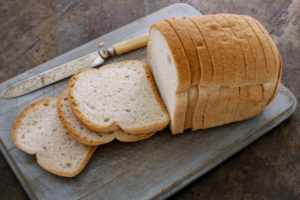Gluten is a type of protein and can be found in rye, barley, and wheat. It helps breads and pastries rise, gives them structure and elasticity. In people with gluten intolerance or celiac disease, eating it can lead to bloating, gas, diarrhoea or more severe conditions like anaemia and osteoporosis.
What should you do if you suffer from these symptoms? First of all, don’t panic! There are many great recipes out there for gluten-free bread and pastries that taste just as good as the original versions! You will need to experiment with some new ingredients, but it’s worth it because soon enough, your tummy won’t be feeling any pain anymore!

Bread
Baking a cake is challenging, but gluten-free cakes have even more skill requirements. The gluten-free dough requires no kneading and has wetter consistency than traditional recipes.
Tips for baking gluten-free bread
- Make sure the bread is cooked completely before removing it from the oven. Use a cooking thermometer to check for an internal temperature of 100 degrees Celsius, and then continue baking until that temperature is reached.
- Gluten-free bread needs to have its shape strengthened by cooling for a few hours before it is sliced. This helps the loaf maintain its shape as it cools, avoiding any collapses while it’s out of the oven.
- To prevent a hot spot, use an oven thermometer to find the hottest part of your oven, then place your bread at least six inches away from it.
Pastry
Converting a regular pastry cake recipe into a gluten-free version is tricky. We have some tips to help you make the perfect flourless tarts.
Read More About: The Difference Between Frosting Vs Buttercream
Tips for gluten-free baking pastry
- Add xanthan gum to gluten-free flour when baking cakes. Xanthan gum enhances the elasticity of gluten-free flours, which makes it easier to work with and less likely to crumble.
- To prevent the pastry from getting too dry when rolling it out, add plenty of water to the gluten-free flour. The dough should be a little sticky before covering and resting in the fridge.
- When baking with gluten-free flours, do not substitute a fat that melts at lower temperatures, such as olive oil or coconut oil for butter or shortening.
- Resting the pastry dough is very important. This will give the gluten enough time to absorb water, so it is easier to knead and roll out. Refrigerate for an hour (minimum) or overnight if desired.
- While baking gluten-free cakes, it can be difficult to roll out the pastry dough thinly and evenly. If you’re hoping to use a rolling pin and flexible sheets of parchment paper (which I highly recommend), try using two pieces of parchment paper rather than one large piece for roller placement.
Read More About: Tips For Baking Gluten-free Cakes
Baking gluten-free bread and pastries can be a bit difficult if you don’t know what you’re doing, but it’s not impossible. These tips for baking gluten-free bread and pastries will help guide you to success!

